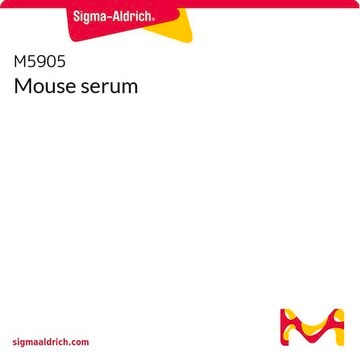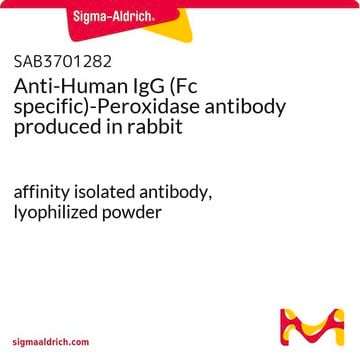SAB4200862
Anti-Salmonella enterica typhimurium antibody produced in rabbit
IgG fraction of antiserum
Sinonimo/i:
Salmonella typhimurium (Loeffler) Castellani and Chalmers
About This Item
Prodotti consigliati
Origine biologica
rabbit
Livello qualitativo
Forma dell’anticorpo
IgG fraction of antiserum
Tipo di anticorpo
primary antibodies
Forma fisica
liquid
Reattività contro le specie
(Salmonella enterica typhimurium)
Confezionamento
pkg of 100 μL
pkg of 25 μL
Concentrazione
~1 mg/mL
tecniche
immunoblotting: 1:2000-1:4000 using Salmonella enterica typhimurium LPS
indirect ELISA: 1:2000-1:4000 using using whole Salmonella
Condizioni di spedizione
dry ice
Temperatura di conservazione
−20°C
modifica post-traduzionali bersaglio
unmodified
Descrizione generale
Specificità
Applicazioni
Azioni biochim/fisiol
higher than the extracellular pH.6 Then, S. typhimurium penetrates the mucus barrier of the intestinal wall and adheres to the epithelium to initiate the infection, that may results in diarrhea, loss of electrolytes and local inflammation of the intestine.7-9
After S. typhimurium is being engulfed by enterocytes, it forms intracellular phagosomal compartments, termed Salmonella-Containing Vacuoles (SCV) where the bacterium is able to survive and multiply.2,9 S. typhimurium has various virulence factors, most of them are enoced by genes located in the Salmonella Pathogenicity Islands (SPI).10 S. typhimurium uses flagella for motility after ingestion11 and then type I fimbrae12 and adhesins to adhere to the epithelium. It expresses Type III Secretion System (T3SS) that enables the bacteria to inject into the host cells a variety of effector proteins such as, SipABCD, SptP, SpiC and SopB that alter cellular functions to promote bacterial invasion, survival and propagation.2,13,14 Moreover, S. typhimurium is able to form resistant biofilms15 that contribute to the establishment of chronic, ""carrier state"" infections. In addition, human specific S. typhiis used as a model for the animal study of typhoid fever.16
Stato fisico
Stoccaggio e stabilità
Esclusione di responsabilità
Not finding the right product?
Try our Motore di ricerca dei prodotti.
Codice della classe di stoccaggio
12 - Non Combustible Liquids
Classe di pericolosità dell'acqua (WGK)
WGK 1
Certificati d'analisi (COA)
Cerca il Certificati d'analisi (COA) digitando il numero di lotto/batch corrispondente. I numeri di lotto o di batch sono stampati sull'etichetta dei prodotti dopo la parola ‘Lotto’ o ‘Batch’.
Possiedi già questo prodotto?
I documenti relativi ai prodotti acquistati recentemente sono disponibili nell’Archivio dei documenti.
Il team dei nostri ricercatori vanta grande esperienza in tutte le aree della ricerca quali Life Science, scienza dei materiali, sintesi chimica, cromatografia, discipline analitiche, ecc..
Contatta l'Assistenza Tecnica.







